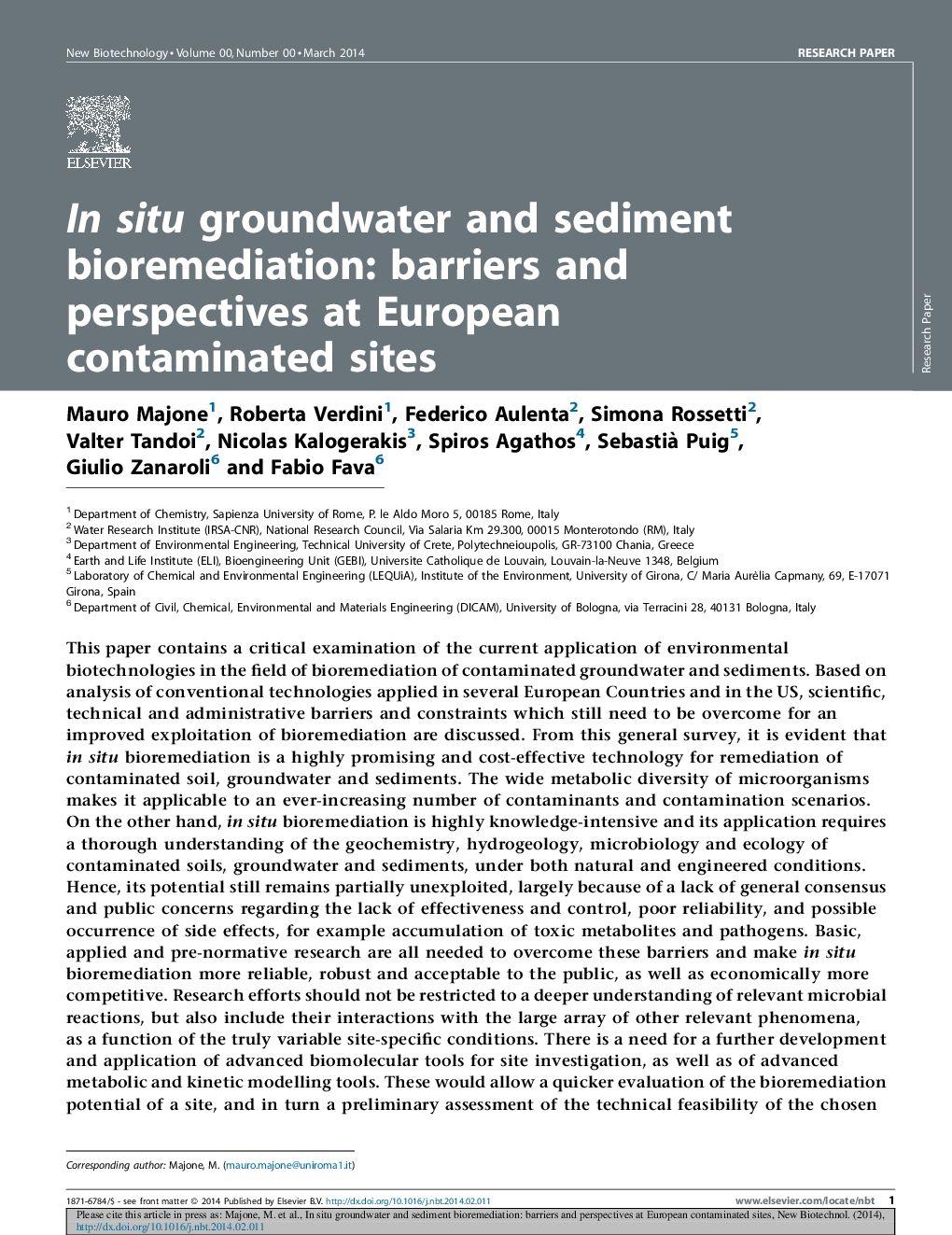| کد مقاله | کد نشریه | سال انتشار | مقاله انگلیسی | نسخه تمام متن |
|---|---|---|---|---|
| 10235034 | 44965 | 2015 | 14 صفحه PDF | دانلود رایگان |
عنوان انگلیسی مقاله ISI
In situ groundwater and sediment bioremediation: barriers and perspectives at European contaminated sites
ترجمه فارسی عنوان
محیط زیست زیرزمینی و رسوب زیست محیطی: موانع و دیدگاه ها در سایت های آلوده اروپایی
دانلود مقاله + سفارش ترجمه
دانلود مقاله ISI انگلیسی
رایگان برای ایرانیان
ترجمه چکیده
این مقاله شامل بررسی بحرانی کاربرد فعلی بیوتکنولوژی زیست محیطی در زمینه برآورد زیست محیطی آب های زیرزمینی و رسوبات آلوده است. بر اساس تجزیه و تحلیل فن آوری های متعارف که در چندین کشور اروپایی و ایالات متحده مورد استفاده قرار می گیرد، موانع و محدودیت های علمی، فنی و اداری که هنوز برای بهره برداری بهتر از محیط زیست بهبود یافته است مورد بحث قرار می گیرد. از این نظرسنجی کلی، واضح است که در زمینه بهبود زیست محیطی فناوری بسیار محتاطانه و مقرون به صرفه برای اصلاح خاک آلوده، آب های زیرزمینی و رسوب است. تنوع متابولیسم وسیع میکروارگانیسم ها باعث می شود تا تعداد زیادی از آلاینده ها و سناریوهای آلودگی به وجود آید. از سوی دیگر، محیط زیست در محیط بسیار دانش آموزی است و کاربرد آن نیازمند درک کامل ژئوشیمی، هیدروژئولوژی، میکروب شناسی و محیط زیست خاک های آلوده، آب های زیرزمینی و رسوبات تحت شرایط طبیعی و مهندسی است. از این رو، این پتانسیل هنوز تا حدودی به علت عدم توافق عمومی و نگرانی های عمومی در مورد عدم اثربخشی و کنترل، قابلیت اطمینان ضعیف و احتمال وقوع عوارض جانبی، به عنوان مثال انباشت متابولیت های سمی و پاتوژن ها، هنوز باقی مانده است. تحقیقات اساسی، کاربردی و پیش از هنجار برای غلبه بر این موانع لازم است و محیط زیست را در محیط اطراف بیشتر قابل اعتماد، قوی و قابل قبول برای عموم و همچنین از لحاظ اقتصادی رقابتی تر می کند. تلاش های تحقیقاتی نباید محدود به درک عمیق تر واکنش های مربوط به میکروبی، بلکه شامل تعاملات آنها با مجموعه ای گسترده از سایر پدیده های مربوطه به عنوان یک عامل از شرایط خاص متغیر سایت باشد. نیاز به توسعه و استفاده از ابزارهای پیشرفته بیولوژیک برای بررسی سایت و نیز ابزارهای پیشرفته متابولیک و جنبشی مدل سازی وجود دارد. این اجازه می دهد تا ارزیابی سریعتری از پتانسیل بهبود زیستی یک سایت داشته باشیم و به نوبه خود ارزیابی اولیه از امکان فنی بودن پروسس انتخاب شده را که می تواند جایگزین یا حداقل نیاز به آزمایش های زمان و گران قیمت را کاهش دهد. در عین حال، آزمایش های زمینه احتمالا برای طراحی دقیق اقدامات اصلاحی در مقیاس کامل اجتناب ناپذیر خواهد بود و ابزارهای گزارش شده در بالا برای طراحی بهتر و عملیات قابل اعتماد مفید خواهد بود.
موضوعات مرتبط
مهندسی و علوم پایه
مهندسی شیمی
بیو مهندسی (مهندسی زیستی)
چکیده انگلیسی
This paper contains a critical examination of the current application of environmental biotechnologies in the field of bioremediation of contaminated groundwater and sediments. Based on analysis of conventional technologies applied in several European Countries and in the US, scientific, technical and administrative barriers and constraints which still need to be overcome for an improved exploitation of bioremediation are discussed. From this general survey, it is evident that in situ bioremediation is a highly promising and cost-effective technology for remediation of contaminated soil, groundwater and sediments. The wide metabolic diversity of microorganisms makes it applicable to an ever-increasing number of contaminants and contamination scenarios. On the other hand, in situ bioremediation is highly knowledge-intensive and its application requires a thorough understanding of the geochemistry, hydrogeology, microbiology and ecology of contaminated soils, groundwater and sediments, under both natural and engineered conditions. Hence, its potential still remains partially unexploited, largely because of a lack of general consensus and public concerns regarding the lack of effectiveness and control, poor reliability, and possible occurrence of side effects, for example accumulation of toxic metabolites and pathogens. Basic, applied and pre-normative research are all needed to overcome these barriers and make in situ bioremediation more reliable, robust and acceptable to the public, as well as economically more competitive. Research efforts should not be restricted to a deeper understanding of relevant microbial reactions, but also include their interactions with the large array of other relevant phenomena, as a function of the truly variable site-specific conditions. There is a need for a further development and application of advanced biomolecular tools for site investigation, as well as of advanced metabolic and kinetic modelling tools. These would allow a quicker evaluation of the bioremediation potential of a site, and in turn a preliminary assessment of the technical feasibility of the chosen bioprocess which could replace or at least reduce the need for time-consuming and expensive field tests. At the same time, field tests will probably remain unavoidable for a detailed design of full scale remedial actions and the above reported tools will in any event be useful for a better design and a more reliable operation.
ناشر
Database: Elsevier - ScienceDirect (ساینس دایرکت)
Journal: New Biotechnology - Volume 32, Issue 1, 25 January 2015, Pages 133-146
Journal: New Biotechnology - Volume 32, Issue 1, 25 January 2015, Pages 133-146
نویسندگان
Mauro Majone, Roberta Verdini, Federico Aulenta, Simona Rossetti, Valter Tandoi, Nicolas Kalogerakis, Spiros Agathos, Sebastià Puig, Giulio Zanaroli, Fabio Fava,
